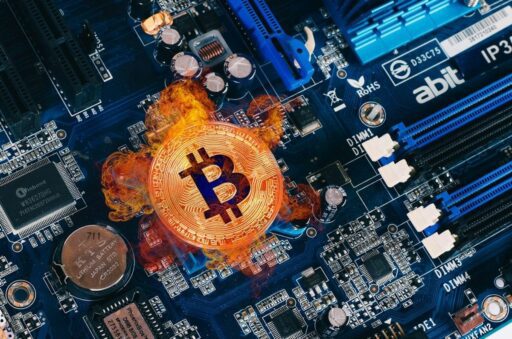Cryptocurrency mining has emerged as an intriguing method for individuals to earn digital currencies like Bitcoin and Ethereum. It involves the use of computer hardware and software to solve mathematical problems, securing transactions on the blockchain and receiving rewards for the effort. For those interested in starting their crypto mining journey, a step-by-step guide can provide the necessary insights and direction needed to embark on this potentially profitable venture.
Key Takeaways
- Crypto mining is the process of verifying transactions and adding them to the blockchain, rewarding miners with cryptocurrency.
- Starting crypto mining requires choosing the right currency, calculating costs and rewards, and selecting appropriate hardware.
- Assembling a mining rig involves careful planning, gathering components, and ensuring compatibility for optimal performance.
- Joining a mining pool can increase the chances of earning rewards by pooling computational resources with other miners.
- Maintaining and scaling up a mining operation is crucial for long-term success and can lead to increased profits.
Understanding the Basics of Crypto Mining


What is Crypto Mining?
Crypto mining is the backbone of the blockchain, providing the necessary computational power to validate and secure transactions. Miners compete to solve mathematical puzzles, and the first to succeed is rewarded with new coins, introducing them into circulation. This process is akin to a digital gold rush, where the ‘miners’ use high-power computers to earn cryptocurrency.
- Transaction Validation: Miners compile transactions into a block.
- Proof of Work: Miners solve puzzles to validate transactions and secure the network.
- Reward: Successful miners receive new coins as a reward.
Crypto mining rigs are powerful computers that perform the calculations needed to mine cryptocurrencies. They are the cornerstone of a miner’s operation, and building one requires careful planning and understanding of the necessary components.
Mining is not just about creating new coins; it’s also about maintaining the integrity and security of the blockchain. Without miners, the blockchain’s decentralized nature would falter, making their role crucial in the cryptocurrency ecosystem.
How Does Mining Work?
Crypto mining is the backbone of cryptocurrency networks, providing security and verifying transactions. Miners collect pending transactions into a block, striving to solve complex mathematical puzzles known as Proof of Work (PoW). This process is not only about creating new coins but also about maintaining the integrity of the blockchain.
Mining difficulty is a critical concept that miners must understand. It reflects the complexity of the cryptographic puzzles that need to be solved to add a new block to the blockchain. As more miners join the network, the difficulty typically increases, making it harder to find the solution and earn the mining reward.
The mining process is a competitive race where the first miner to solve the puzzle gets to add the block to the blockchain and receive the cryptocurrency reward.
Here’s a simplified view of the mining steps:
- Transaction Validation: Grouping pending transactions into a new block.
- Proof of Work: Competing to solve the cryptographic puzzle.
- Block Addition: Successfully adding the block to the blockchain.
- Reward Allocation: Receiving cryptocurrency as a reward for the mining efforts.
The Role of Miners in Blockchain Technology
Miners play a pivotal role in the blockchain ecosystem, ensuring the security and functionality of the network. They validate and record transactions, forming the backbone of the blockchain’s integrity. Without miners, the blockchain would be susceptible to fraudulent activities and double-spending.
- Transaction Verification: Miners check the authenticity of transactions and add them to the blockchain.
- Network Security: By solving complex cryptographic puzzles, miners protect the network from attacks.
- Block Creation: Miners are responsible for creating new blocks, which are essential for the continuity of the blockchain.
Miners are not just participants in the blockchain; they are the custodians of its trustworthiness and stability. Their role is critical in maintaining the decentralized nature of the technology, making them integral to the blockchain’s success.
Preparing for Your Crypto Mining Journey


Choosing the Right Cryptocurrency to Mine
Selecting the right cryptocurrency to mine is a pivotal decision that can significantly impact the profitability and longevity of your mining venture. Begin by researching various cryptocurrencies to understand their mining algorithms, potential profitability, and long-term viability. Market demand, technological innovation, and community support are critical factors to consider.
When assessing which cryptocurrency to mine, compatibility with your mining hardware is essential. Different cryptocurrencies may require specific algorithms or hardware configurations, particularly GPUs. Here’s a quick checklist to guide you through the process:
- Research the mining algorithms and profitability of various cryptocurrencies.
- Determine hardware compatibility with potential cryptocurrencies.
- Evaluate the security and stability of the cryptocurrency’s network.
- Consider the size and reputation of the mining community.
By conducting thorough research and assessing factors such as hardware compatibility and network security, you can make informed decisions that align with your mining goals.
Bitcoin retains its position as the world’s leading cryptocurrency and, despite technological advancements, continues to be a profitable choice for miners. However, it’s crucial to stay updated with the latest trends and predictions, such as those found in resources like ‘The 7 Best Cryptos to Mine in 2024: A Comprehensive Guide – KuCoin’.
Calculating the Costs and Potential Rewards
Before embarking on your mining adventure, it’s crucial to calculate the potential profitability of your operation. This involves analyzing various factors that impact your bottom line. Use online calculators to estimate potential earnings, considering the cost of your hardware, electricity, and the current cryptocurrency prices.
- Analyze current and historical profitability of mining different cryptocurrencies.
- Consider mining difficulty, block rewards, and transaction fees.
- Factor in variable costs like electricity and maintenance.
Keeping a close eye on cryptocurrency prices is essential, as they directly affect your mining rewards. Remember, the initial investment in mining hardware can be substantial, but with careful planning and continuous learning, profitability is within reach.
While the rewards of mining can be enticing, always be aware of the risks involved. Cryptocurrencies can be highly volatile, and there’s no guarantee of success. However, for those who set clear goals, budget effectively, and stay informed, crypto mining can be a profitable endeavor.
Selecting and Sourcing Your Mining Hardware
Selecting the right mining hardware is crucial for a successful crypto mining operation. By carefully selecting and assembling these components, you can build a powerful and efficient mining rig. It’s essential to consider the compatibility of your hardware with the cryptocurrency you intend to mine, as well as the overall profitability of your setup.
When purchasing hardware, especially ASICs, it’s important to buy directly from the manufacturer to avoid scams. Look for devices with high hash rates and efficiency levels. Here’s a simple checklist to guide you through the process:
- Research which cryptocurrency you want to mine and the hardware requirements.
- Set a budget and choose components that offer the best value for money.
- Ensure the GPUs you select are compatible with other components in your rig.
- Consider the long-term viability and market demand of the cryptocurrency.
Remember, the goal is to maximize efficiency and profitability while contributing to the decentralized network. Assessing the costs and benefits of different hardware options will help you make an informed decision.
Building Your Mining Rig: A Step-by-Step Approach


Assembling the Necessary Components
Before you begin assembling your mining rig, it’s crucial to have all the necessary components on hand. Ensure all components are compatible with each other to avoid any potential issues during setup. Start by setting up a clean, well-lit workspace with adequate ventilation, as you’ll be handling delicate electronic parts.
- Purchase all necessary components including GPUs, CPU, motherboard, RAM, PSU, storage, cooling system, mining frame or case, and peripherals.
- Gather necessary tools such as screwdrivers, cable ties, and thermal paste for the assembly process.
By carefully selecting and assembling these components, you can build a powerful and efficient mining rig capable of generating cryptocurrency rewards and contributing to the decentralized network.
Remember to follow the manufacturer’s guidelines when installing the CPU into the motherboard socket, inserting the RAM modules, and setting up storage with SATA cables. Proper cable management and airflow within the frame or case are essential for maintaining the longevity and efficiency of your mining rig.
Setting Up the Mining Software
Once you have your mining hardware assembled, the next crucial step is to install and configure the mining software. Choosing the right mining software is essential, as it will act as the bridge between your mining hardware and the blockchain network. Here’s how to get started:
- Install your preferred operating system (e.g., Windows, Linux) onto the SSD or HDD.
- Download and install mining software that is compatible with your chosen cryptocurrency and GPU configuration.
- Configure your mining software settings, which includes entering pool information and adjusting overclocking options if desired.
Remember to securely set up your cryptocurrency wallet to store your earnings before initiating the mining process.
After setting up the software, it’s important to test your system to ensure everything is running smoothly. This includes verifying that your mining rig is effectively communicating with the network and that your wallet is correctly receiving the mining rewards. Speak with your energy supplier to avoid any operational downtime, as mining can significantly increase your power consumption.
Optimizing Your Rig for Maximum Efficiency
Efficiency is the cornerstone of a successful mining operation. Optimizing your mining rig is not just about increasing its computational power; it’s also about reducing energy consumption to lower operational costs. Given that electricity can be one of the most significant expenses, striking the right balance between power and consumption is essential.
To achieve this, you’ll need to consider the type of mining rig you’re using. Consumer-grade GPUs are a common choice for beginners, but for those looking to mine specific cryptocurrencies like Bitcoin, ASIC miners may be more appropriate. Each rig type has its own set of optimization strategies.
Remember, a well-optimized rig is a profitable one. Regularly monitor your rig’s performance, including hash rates and electricity costs, and adjust your setup as needed to maintain efficiency.
Here’s a quick checklist to help you optimize your mining rig:
- Select the right components for your specific mining goals.
- Configure your hardware to achieve the maximum hash rate.
- Implement energy efficiency best practices to reduce costs.
- Stay informed about the latest in crypto mining technology to adapt to new algorithms.
- Continuously assess the profitability of your mining rig to ensure it remains competitive.
Joining a Mining Pool and Starting Your Miner


Understanding Mining Pools and Their Benefits
Mining pools are a collective effort where individual miners combine their computational power to increase the likelihood of solving blocks and earning rewards. Mining pools increase miners’ chances of earning cryptocurrency by pooling computational power, which can lead to more consistent payouts compared to solo mining. This collaboration mitigates the risk of receiving no rewards for extended periods due to the competitive nature of mining.
Pool mining is akin to a communal farming effort where everyone contributes and shares in the harvest. It’s a strategic approach to navigate the unpredictable waves of market volatility that impact profitability.
Understanding the reward distribution structure of a mining pool is crucial. Familiarize yourself with different methods such as pay-per-share (PPS) or proportional rewards. Assessing pool performance and reliability is also key, as is configuring software and optimizing for energy efficiency. Here’s a quick checklist to consider when evaluating mining pools:
- Look for consistent payouts and reliable infrastructure.
- Check for transparent communication and miner feedback.
- Join multiple pools for diversification and risk mitigation.
- Stay informed and adapt your strategy to maximize earnings.
How to Choose a Mining Pool
Choosing the right mining pool is a critical decision for any miner. Mining pools all have various ways of sharing rewards, assigning work, and charging fees. It’s essential to understand the inner workings of mining pools to make an informed choice. Here are some steps to guide you:
- Research the pool’s reputation by reading reviews and checking feedback from other miners.
- Consider the pool size and stability; larger pools tend to offer more regular payouts.
- Assess the pool’s performance and reliability, ensuring consistent payouts and minimal downtime.
- Check the pool’s compatibility with your hardware and software, as well as any specific requirements they may have.
- Understand the pool’s reward structure and fee system to ensure it aligns with your mining goals.
When evaluating mining pools, prioritize transparency and a track record of fair and consistent payouts. This will help you avoid pools that might charge hidden fees or distribute rewards unevenly.
Finally, remember that joining a mining pool is a partnership. You’re entrusting your computing power to a collective effort, so choose a pool that values its members and operates with integrity.
Configuring Your Miner and Initiating the Mining Process
Once you have your mining hardware set up, the next crucial step is to configure your mining software. This involves adjusting the operating times and frequency settings to match your hardware’s capabilities and entering your Bitcoin wallet address to receive mining rewards.
Before you start mining, it’s essential to run stability tests to ensure all components are functioning correctly. Monitor temperatures, hash rates, and power consumption to optimize performance.
After ensuring that your system is stable, you can proceed to join a mining pool. Here’s a simple checklist to guide you through this process:
- Register an account with your chosen mining pool.
- Configure your mining software with the pool’s server details.
- Start the mining process and monitor your progress through the pool’s dashboard.
Remember to communicate with your energy supplier to prevent any operational downtime. This step is often overlooked but can be crucial for uninterrupted mining operations.
Maintaining Your Mining Operation and Scaling Up
Routine Maintenance and Troubleshooting
To ensure the longevity and efficiency of your mining operation, routine maintenance is crucial. This involves regular checks and cleaning to prevent dust buildup, which can lead to overheating and reduced performance. Adequate ventilation is essential to maintain a cool environment for your mining hardware.
Monitoring your mining rig’s performance is equally important. Keep an eye on hash rates, temperature, and power consumption. Adjustments may be necessary to optimize for efficiency and profitability. Stay updated with the latest software and protocol changes to keep your operation running smoothly.
Remember, a well-maintained mining rig is less likely to encounter unexpected downtime, which can be costly in terms of both repairs and lost mining time.
Here’s a simple checklist for maintenance and troubleshooting:
- Ensure proper airflow around the mining setup.
- Clean dust and debris to prevent blockages in cooling systems.
- Monitor hardware health and performance, making adjustments as needed.
- Stay informed about updates to mining software and cryptocurrency protocols.
Assessing Performance and Making Improvements
To maintain a profitable crypto mining operation, it’s crucial to continuously assess performance and implement improvements. This involves monitoring key metrics such as hash rates, power consumption, and overall system stability. Regularly evaluating these factors can lead to optimizations that enhance efficiency and profitability.
- Run stability tests to ensure all components are functioning properly.
- Monitor temperatures, hash rates, and power consumption to optimize performance and efficiency.
- Make any necessary adjustments to hardware or software settings to achieve desired results.
By keeping a close eye on the operational aspects of your mining rig, you can make informed decisions that boost your mining output and reduce costs.
Understanding the financial aspects of your mining operation is also essential. Analyze the power and running expenses to ensure that your efforts remain cost-effective. Adjustments may be needed to stay ahead in the ever-evolving crypto mining landscape.
Expanding Your Mining Setup for Increased Profits
Once you’ve established a stable mining operation, the next step is to scale up for increased profits. Diversifying your mining portfolio can mitigate risks and maximize potential returns. This involves adding more hardware, exploring different cryptocurrencies, and possibly joining multiple mining pools for better reward opportunities.
To ensure a smooth expansion, consider the following:
- Monitor market trends and adjust your mining strategy accordingly.
- Reinvest profits into buying additional and more efficient mining rigs.
- Run stability tests and optimize performance regularly.
Remember, expanding your mining setup requires careful planning and a willingness to adapt to the ever-changing crypto landscape. Stay informed and be prepared to adjust your strategies for long-term success.
Finally, keep a close eye on the Bitcoin difficulty and electricity costs, as these will directly impact your profitability. By staying vigilant and proactive, you can scale your mining operation effectively and sustainably.
Conclusion
Embarking on the journey of crypto mining can be both exciting and rewarding. As we’ve explored in this beginner’s guide, the key to success lies in careful planning, selecting the right cryptocurrency, investing in suitable hardware, and joining a mining pool to increase your chances of earning rewards. Remember, crypto mining is not just about the potential profits; it’s about contributing to the blockchain network and being part of a revolutionary digital economy. While it requires a significant investment of time, resources, and continuous learning, the satisfaction of mining your own digital currency is unparalleled. Stay informed, stay patient, and you may find that crypto mining is a fulfilling addition to your digital endeavors.
Frequently Asked Questions
What exactly is cryptocurrency mining?
Cryptocurrency mining is the process by which transactions are verified and added to the blockchain ledger. Miners use computer hardware and software to solve complex mathematical problems, and as a reward for their efforts, they receive a small amount of the cryptocurrency.
How can a beginner start crypto mining?
Beginners can start crypto mining by choosing a cryptocurrency to mine, researching and investing in the appropriate hardware, setting up mining software, joining a mining pool to increase chances of earning rewards, and starting the mining process to solve mathematical puzzles and validate transactions.
What factors should I consider when choosing a cryptocurrency to mine?
When choosing a cryptocurrency to mine, consider factors such as the coin’s profitability, network difficulty, hardware requirements, and potential for future value. Research is essential to determine the best option for your goals and budget.
What are the essential components needed to build a mining rig?
The essential components for a mining rig typically include a motherboard, CPU, memory, storage, power supply unit, cooling systems, and one or more graphics processing units (GPUs) or specialized ASIC miners, depending on the cryptocurrency you plan to mine.
What are the benefits of joining a mining pool?
Joining a mining pool allows you to combine your computational power with other miners, which increases your chances of earning mining rewards. It helps to distribute the mining income more evenly and consistently, as opposed to mining solo where rewards can be infrequent and unpredictable.
How do I maintain and scale up my mining operation?
To maintain and scale up your mining operation, perform routine maintenance on your hardware, troubleshoot any issues promptly, monitor performance, and make improvements where necessary. To increase profits, consider expanding your setup with additional or more powerful hardware.






